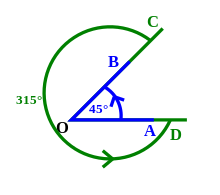


InEuclidean geometry, an angle is the figure formed by two rays, called the sides of the angle, sharing a common endpoint, called the vertex of the angle.[1] Angles formed by two rays are also known as plane angles as they lie in the plane that contains the rays. Angles are also formed by the intersection of two planes; these are called dihedral angles. Two intersecting curves may also define an angle, which is the angle of the rays lying tangent to the respective curves at their point of intersection.
The magnitude of an angle is called an angular measure or simply "angle". Angle of rotation is a measure conventionally defined as the ratio of a circular arc length to its radius, and may be a negative number. In the case of a geometric angle, the arc is centered at the vertex and delimited by the sides. In the case of a rotation, the arc is centered at the center of the rotation and delimited by any other point and its image by the rotation.
The word angle comes from the Latin word angulus, meaning "corner". Cognate words include the Greek ἀγκύλος (ankylοs) meaning "crooked, curved" and the English word "ankle". Both are connected with the Proto-Indo-European root *ank-, meaning "to bend" or "bow".[2]
Euclid defines a plane angle as the inclination to each other, in a plane, of two lines that meet each other and do not lie straight with respect to each other. According to the Neoplatonic metaphysician Proclus, an angle must be either a quality, a quantity, or a relationship. The first concept, angle as quality, was used by Eudemus of Rhodes, who regarded an angle as a deviation from a straight line; the second, angle as quality, by Carpus of Antioch, who regarded it as the interval or space between the intersecting lines; Euclid adopted the third: angle as a relationship.[3]
Inmathematical expressions, it is common to use Greek letters (α, β, γ, θ, φ, . . . ) as variables denoting the size of some angle[4] (the symbol π is typically not used for this purpose to avoid confusion with the constant denoted by that symbol). Lower case Roman letters (a, b, c, . . . ) are also used. In contexts where this is not confusing, an angle may be denoted by the upper case Roman letter denoting its vertex. See the figures in this article for examples.
The three defining points may also identify angles in geometric figures. For example, the angle with vertex A formed by the rays AB and AC (that is, the half-lines from point A through points B and C) is denoted ∠BACor
In other ways, an angle denoted as, say, ∠BAC might refer to any of four angles: the clockwise angle from B to C about A, the anticlockwise angle from B to C about A, the clockwise angle from C to B about A, or the anticlockwise angle from C to B about A, where the direction in which the angle is measured determines its sign (see § Signed angles). However, in many geometrical situations, it is evident from the context that the positive angle less than or equal to 180 degrees is meant, and in these cases, no ambiguity arises. Otherwise, to avoid ambiguity, specific conventions may be adopted so that, for instance, ∠BAC always refers to the anticlockwise (positive) angle from B to C about A and ∠CAB the anticlockwise (positive) angle from C to B about A.
There is some common terminology for angles, whose measure is always non-negative (see § Signed angles):
The names, intervals, and measuring units are shown in the table below:
| Name | zero angle | acute angle | right angle | obtuse angle | straight angle | reflex angle | perigon | |||
| Unit | Interval | |||||||||
|---|---|---|---|---|---|---|---|---|---|---|
| turn | 0 turn | (0, 1/4) turn | 1/4 turn | (1/4, 1/2) turn | 1/2 turn | (1/2, 1) turn | 1 turn | |||
| radian | 0 rad | (0, 1/2π) rad | 1/2π rad | (1/2π, π) rad | π rad | (π, 2π) rad | 2π rad | |||
| degree | 0° | (0, 90)° | 90° | (90, 180)° | 180° | (180, 360)° | 360° | |||
| gon | 0g | (0, 100)g | 100g | (100, 200)g | 200g | (200, 400)g | 400g | |||

When two straight lines intersect at a point, four angles are formed. Pairwise, these angles are named according to their location relative to each other.
The equality of vertically opposite angles is called the vertical angle theorem. Eudemus of Rhodes attributed the proof to Thales of Miletus.[9][10] The proposition showed that since both of a pair of vertical angles are supplementary to both of the adjacent angles, the vertical angles are equal in measure. According to a historical note,[10] when Thales visited Egypt, he observed that whenever the Egyptians drew two intersecting lines, they would measure the vertical angles to make sure that they were equal. Thales concluded that one could prove that all vertical angles are equal if one accepted some general notions such as:
When two adjacent angles form a straight line, they are supplementary. Therefore, if we assume that the measure of angle A equals x, the measure of angle C would be 180° − x. Similarly, the measure of angle D would be 180° − x. Both angle C and angle D have measures equal to 180° − x and are congruent. Since angle B is supplementary to both angles C and D, either of these angle measures may be used to determine the measure of Angle B. Using the measure of either angle C or angle D, we find the measure of angle B to be 180° − (180° − x) = 180° − 180° + x = x. Therefore, both angle A and angle B have measures equal to x and are equal in measure.

Atransversal is a line that intersects a pair of (often parallel) lines and is associated with exterior angles, interior angles, alternate exterior angles, alternate interior angles, corresponding angles, and consecutive interior angles.[11]
The angle addition postulate states that if B is in the interior of angle AOC, then

I.e., the measure of the angle AOC is the sum of the measure of angle AOB and the measure of angle BOC.
Three special angle pairs involve the summation of angles:

The adjective complementary is from the Latin complementum, associated with the verb complere, "to fill up". An acute angle is "filled up" by its complement to form a right angle.
The difference between an angle and a right angle is termed the complement of the angle.[13]
If angles A and B are complementary, the following relationships hold: ![{\displaystyle {\begin{aligned}&\sin ^{2}A+\sin ^{2}B=1&&\cos ^{2}A+\cos ^{2}B=1\\[3pt]&\tan A=\cot B&&\sec A=\csc B\end{aligned}}}](https://wikimedia.org/api/rest_v1/media/math/render/svg/47aa6b35b8e53468f73d7ec051d55371da314fba)
(The tangent of an angle equals the cotangent of its complement, and its secant equals the cosecant of its complement.)
The prefix "co-" in the names of some trigonometric ratios refers to the word "complementary".

If the two supplementary angles are adjacent (i.e., have a common vertex and share just one side), their non-shared sides form a straight line. Such angles are called a linear pair of angles.[15] However, supplementary angles do not have to be on the same line and can be separated in space. For example, adjacent angles of a parallelogram are supplementary, and opposite angles of a cyclic quadrilateral (one whose vertices all fall on a single circle) are supplementary.
If a point P is exterior to a circle with center O, and if the tangent lines from P touch the circle at points T and Q, then ∠TPQ and ∠TOQ are supplementary.
The sines of supplementary angles are equal. Their cosines and tangents (unless undefined) are equal in magnitude but have opposite signs.
In Euclidean geometry, any sum of two angles in a triangle is supplementary to the third because the sum of the internal angles of a triangle is a straight angle.

The difference between an angle and a complete angle is termed the explement of the angle or conjugate of an angle.

The size of a geometric angle is usually characterized by the magnitude of the smallest rotation that maps one of the rays into the other. Angles of the same size are said to be equal congruentorequal in measure.
In some contexts, such as identifying a point on a circle or describing the orientation of an object in two dimensions relative to a reference orientation, angles that differ by an exact multiple of a full turn are effectively equivalent. In other contexts, such as identifying a point on a spiral curve or describing an object's cumulative rotation in two dimensions relative to a reference orientation, angles that differ by a non-zero multiple of a full turn are not equivalent.

To measure an angle θ, a circular arc centered at the vertex of the angle is drawn, e.g., with a pair of compasses. The ratio of the length s of the arc by the radius r of the circle is the number of radians in the angle:[20]

The angle expressed by another angular unit may then be obtained by multiplying the angle by a suitable conversion constant of the form k/2π, where k is the measure of a complete turn expressed in the chosen unit (for example, k = 360° for degrees or 400 grad for gradians):

The value of θ thus defined is independent of the size of the circle: if the length of the radius is changed, then the arc length changes in the same proportion, so the ratio s/r is unaltered.[nb 1]

Throughout history, angles have been measured in various units. These are known as angular units, with the most contemporary units being the degree ( ° ), the radian (rad), and the gradian (grad), though many others have been used throughout history.[22] Most units of angular measurement are defined such that one turn (i.e., the angle subtended by the circumference of a circle at its centre) is equal to n units, for some whole number n. Two exceptions are the radian (and its decimal submultiples) and the diameter part.
In the International System of Quantities, an angle is defined as a dimensionless quantity, and in particular, the radian unit is dimensionless. This convention impacts how angles are treated in dimensional analysis.
The following table list some units used to represent angles.
| Name | Number in one turn | In degrees | Description |
|---|---|---|---|
| radian | 2π | ≈57°17′ | The radian is determined by the circumference of a circle that is equal in length to the radius of the circle (n = 2π = 6.283...). It is the angle subtended by an arc of a circle that has the same length as the circle's radius. The symbol for radian is rad. One turn is 2π radians, and one radian is 180°/π, or about 57.2958 degrees. Often, particularly in mathematical texts, one radian is assumed to equal one, resulting in the unit rad being omitted. The radian is used in virtually all mathematical work beyond simple, practical geometry due, for example, to the pleasing and "natural" properties that the trigonometric functions display when their arguments are in radians. The radian is the (derived) unit of angular measurement in the SI. |
| degree | 360 | 1° | The degree, denoted by a small superscript circle (°), is 1/360 of a turn, so one turn is 360°. One advantage of this old sexagesimal subunit is that many angles common in simple geometry are measured as a whole number of degrees. Fractions of a degree may be written in normal decimal notation (e.g., 3.5° for three and a half degrees), but the "minute" and "second" sexagesimal subunits of the『degree–minute–second』system (discussed next) are also in use, especially for geographical coordinates and in astronomy and ballistics (n = 360) |
| arcminute | 21,600 | 0°1′ | The minute of arc (orMOA, arcminute, or just minute) is 1/60 of a degree = 1/21,600 turn. It is denoted by a single prime ( ′ ). For example, 3° 30′ is equal to 3 × 60 + 30 = 210 minutes or 3 + 30/60 = 3.5 degrees. A mixed format with decimal fractions is sometimes used, e.g., 3° 5.72′ = 3 + 5.72/60 degrees. A nautical mile was historically defined as an arcminute along a great circle of the Earth. (n = 21,600). |
| arcsecond | 1,296,000 | 0°0′1″ | The second of arc (orarcsecond, or just second) is 1/60 of a minute of arc and 1/3600 of a degree (n = 1,296,000). It is denoted by a double prime ( ″ ). For example, 3° 7′ 30″ is equal to 3 + 7/60 + 30/3600 degrees, or 3.125 degrees. The arcsecond is the angle used to measure a parsec |
| grad | 400 | 0°54′ | The grad, also called grade, gradian, or gon. It is a decimal subunit of the quadrant. A right angle is 100 grads. A kilometre was historically defined as a centi-grad of arc along a meridian of the Earth, so the kilometer is the decimal analog to the sexagesimal nautical mile (n = 400). The grad is used mostly in triangulation and continental surveying. |
| turn | 1 | 360° | The turn is the angle subtended by the circumference of a circle at its centre. A turn is equal to 2πor𝜏 (tau) radians. |
| hour angle | 24 | 15° | The astronomical hour angleis1/24 turn. As this system is amenable to measuring objects that cycle once per day (such as the relative position of stars), the sexagesimal subunits are called minute of time and second of time. These are distinct from, and 15 times larger than, minutes and seconds of arc. 1 hour = 15° = π/12 rad = 1/6 quad = 1/24 turn = 16+2/3 grad. |
| (compass) point | 32 | 11.25° | The pointorwind, used in navigation, is 1/32 of a turn. 1 point = 1/8 of a right angle = 11.25° = 12.5 grad. Each point is subdivided into four quarter points, so one turn equals 128. |
| milliradian | 2000π | ≈0.057° | The true milliradian is defined as a thousandth of a radian, which means that a rotation of one turn would equal exactly 2000π mrad (or approximately 6283.185 mrad). Almost all scope sights for firearms are calibrated to this definition. In addition, three other related definitions are used for artillery and navigation, often called a 'mil', which are approximately equal to a milliradian. Under these three other definitions, one turn makes up for exactly 6000, 6300, or 6400 mils, spanning the range from 0.05625 to 0.06 degrees (3.375 to 3.6 minutes). In comparison, the milliradian is approximately 0.05729578 degrees (3.43775 minutes). One "NATO mil" is defined as 1/6400 of a turn. Just like with the milliradian, each of the other definitions approximates the milliradian's useful property of subtensions, i.e. that the value of one milliradian approximately equals the angle subtended by a width of 1 meter as seen from 1 km away (2π/6400 = 0.0009817... ≈ 1/1000). |
| binary degree | 256 | 1°33'45" | The binary degree, also known as the binary radianorbradorbinary angular measurement (BAM).[23] The binary degree is used in computing so that an angle can be efficiently represented in a single byte (albeit to limited precision). Other measures of the angle used in computing may be based on dividing one whole turn into 2n equal parts for other values of n. |
| π radian | 2 | 180° | The multiples of π radians (MULπ) unit is implemented in the RPN scientific calculator WP 43S.[25] See also: IEEE 754 recommended operations |
| quadrant | 4 | 90° | One quadrant is a 1/4 turn and also known as a right angle. The quadrant is the unit in Euclid's Elements. In German, the symbol ∟ has been used to denote a quadrant. 1 quad = 90° = π/2 rad = 1/4 turn = 100 grad. |
| sextant | 6 | 60° | The sextant was the unit used by the Babylonians,[26][27] The degree, minute of arc and second of arc are sexagesimal subunits of the Babylonian unit. It is straightforward to construct with ruler and compasses. It is the angle of the equilateral triangle or is 1/6 turn. 1 Babylonian unit = 60° = π/3 rad ≈ 1.047197551 rad. |
| hexacontade | 60 | 6° | The hexacontade is a unit used by Eratosthenes. It equals 6°, so a whole turn was divided into 60 hexacontades. |
| pechus | 144 to 180 | 2° to 2+1/2° | The pechus was a Babylonian unit equal to about 2° or 2+1/2°. |
| diameter part | ≈376.991 | ≈0.95493° | The diameter part (occasionally used in Islamic mathematics) is 1/60 radian. One "diameter part" is approximately 0.95493°. There are about 376.991 diameter parts per turn. |
| zam | 224 | ≈1.607° | In old Arabia, a turn was subdivided into 32 Akhnam, and each akhnam was subdivided into 7 zam so that a turn is 224 zam. |
Plane angle may be defined as θ = s/r, where θ is the subtended angle in radians, s is arc length, and r is radius. One radian corresponds to the angle for which s = r, hence 1 radian = 1 m/m.[28] However, rad is only to be used to express angles, not to express ratios of lengths in general.[29] A similar calculation using the area of a circular sector θ = 2A/r2 gives 1 radian as 1 m2/m2.[30] The key fact is that the radian is a dimensionless unit equal to 1. In SI 2019, the radian is defined accordingly as 1 rad = 1.[31] It is a long-established practice in mathematics and across all areas of science to make use of rad = 1.[32][33]
Giacomo Prando writes "the current state of affairs leads inevitably to ghostly appearances and disappearances of the radian in the dimensional analysis of physical equations".[34] For example, an object hanging by a string from a pulley will rise or drop by y = rθ centimeters, where r is the radius of the pulley in centimeters and θ is the angle the pulley turns in radians. When multiplying rbyθ the unit of radians disappears from the result. Similarly in the formula for the angular velocity of a rolling wheel, ω = v/r, radians appear in the units of ω but not on the right hand side.[35] Anthony French calls this phenomenon "a perennial problem in the teaching of mechanics".[36] Oberhofer says that the typical advice of ignoring radians during dimensional analysis and adding or removing radians in units according to convention and contextual knowledge is "pedagogically unsatisfying".[37]
In 1993 the American Association of Physics Teachers Metric Committee specified that the radian should explicitly appear in quantities only when different numerical values would be obtained when other angle measures were used, such as in the quantities of angle measure (rad), angular speed (rad/s), angular acceleration (rad/s2), and torsional stiffness (N⋅m/rad), and not in the quantities of torque (N⋅m) and angular momentum (kg⋅m2/s).[38]
At least a dozen scientists between 1936 and 2022 have made proposals to treat the radian as a base unit of measurement for a base quantity (and dimension) of "plane angle".[39][40][41] Quincey's review of proposals outlines two classes of proposal. The first option changes the unit of a radius to meters per radian, but this is incompatible with dimensional analysis for the area of a circle, πr2. The other option is to introduce a dimensional constant. According to Quincey this approach is "logically rigorous" compared to SI, but requires "the modification of many familiar mathematical and physical equations".[42] A dimensional constant for angle is "rather strange" and the difficulty of modifying equations to add the dimensional constant is likely to preclude widespread use.[41]
In particular, Quincey identifies Torrens' proposal to introduce a constant η equal to 1 inverse radian (1 rad−1) in a fashion similar to the introduction of the constant ε0.[42][a] With this change the formula for the angle subtended at the center of a circle, s = rθ, is modified to become s = ηrθ, and the Taylor series for the sine of an angle θ becomes:[41][43]




Current SI can be considered relative to this framework as a natural unit system where the equation η = 1 is assumed to hold, or similarly, 1 rad = 1. This radian convention allows the omission of η in mathematical formulas.[46]
Defining radian as a base unit may be useful for software, where the disadvantage of longer equations is minimal.[47] For example, the Boost units library defines angle units with aplane_angle dimension,[48] and Mathematica's unit system similarly considers angles to have an angle dimension.[49][50]

It is frequently helpful to impose a convention that allows positive and negative angular values to represent orientations and/or rotations in opposite directions or "sense" relative to some reference.
In a two-dimensional Cartesian coordinate system, an angle is typically defined by its two sides, with its vertex at the origin. The initial side is on the positive x-axis, while the other side or terminal side is defined by the measure from the initial side in radians, degrees, or turns, with positive angles representing rotations toward the positive y-axis and negative angles representing rotations toward the negative y-axis. When Cartesian coordinates are represented by standard position, defined by the x-axis rightward and the y-axis upward, positive rotations are anticlockwise, and negative cycles are clockwise.
In many contexts, an angle of −θ is effectively equivalent to an angle of "one full turn minus θ". For example, an orientation represented as −45° is effectively equal to an orientation defined as 360° − 45° or 315°. Although the final position is the same, a physical rotation (movement) of −45° is not the same as a rotation of 315° (for example, the rotation of a person holding a broom resting on a dusty floor would leave visually different traces of swept regions on the floor).
In three-dimensional geometry, "clockwise" and "anticlockwise" have no absolute meaning, so the direction of positive and negative angles must be defined in terms of an orientation, which is typically determined by a normal vector passing through the angle's vertex and perpendicular to the plane in which the rays of the angle lie.
Innavigation, bearingsorazimuth are measured relative to north. By convention, viewed from above, bearing angles are positive clockwise, so a bearing of 45° corresponds to a north-east orientation. Negative bearings are not used in navigation, so a north-west orientation corresponds to a bearing of 315°.
For an angular unit, it is definitional that the angle addition postulate holds. Some quantities related to angles where the angle addition postulate does not hold include:

The angle between a line and a curve (mixed angle) or between two intersecting curves (curvilinear angle) is defined to be the angle between the tangents at the point of intersection. Various names (now rarely, if ever, used) have been given to particular cases:—amphicyrtic (Gr. ἀμφί, on both sides, κυρτός, convex) or cissoidal (Gr. κισσός, ivy), biconvex; xystroidalorsistroidal (Gr. ξυστρίς, a tool for scraping), concavo-convex; amphicoelic (Gr. κοίλη, a hollow) or angulus lunularis, biconcave.[53]
The ancient Greek mathematicians knew how to bisect an angle (divide it into two angles of equal measure) using only a compass and straightedge but could only trisect certain angles. In 1837, Pierre Wantzel showed that this construction could not be performed for most angles.
In the Euclidean space, the angle θ between two Euclidean vectors u and v is related to their dot product and their lengths by the formula

This formula supplies an easy method to find the angle between two planes (or curved surfaces) from their normal vectors and between skew lines from their vector equations.
To define angles in an abstract real inner product space, we replace the Euclidean dot product ( · ) by the inner product 

In a complex inner product space, the expression for the cosine above may give non-real values, so it is replaced with

or, more commonly, using the absolute value, with

The latter definition ignores the direction of the vectors. It thus describes the angle between one-dimensional subspaces 



The definition of the angle between one-dimensional subspaces 


in a Hilbert space can be extended to subspaces of finite dimensions. Given two subspaces 



InRiemannian geometry, the metric tensor is used to define the angle between two tangents. Where U and V are tangent vectors and gij are the components of the metric tensor G,

Ahyperbolic angle is an argument of a hyperbolic function just as the circular angle is the argument of a circular function. The comparison can be visualized as the size of the openings of a hyperbolic sector and a circular sector since the areas of these sectors correspond to the angle magnitudes in each case.[54] Unlike the circular angle, the hyperbolic angle is unbounded. When the circular and hyperbolic functions are viewed as infinite series in their angle argument, the circular ones are just alternating series forms of the hyperbolic functions. This comparison of the two series corresponding to functions of angles was described by Leonhard EulerinIntroduction to the Analysis of the Infinite (1748).
Ingeography, the location of any point on the Earth can be identified using a geographic coordinate system. This system specifies the latitude and longitude of any location in terms of angles subtended at the center of the Earth, using the equator and (usually) the Greenwich meridian as references.
Inastronomy, a given point on the celestial sphere (that is, the apparent position of an astronomical object) can be identified using any of several astronomical coordinate systems, where the references vary according to the particular system. Astronomers measure the angular separation of two stars by imagining two lines through the center of the Earth, each intersecting one of the stars. The angle between those lines and the angular separation between the two stars can be measured.
In both geography and astronomy, a sighting direction can be specified in terms of a vertical angle such as altitude /elevation with respect to the horizon as well as the azimuth with respect to north.
Astronomers also measure objects' apparent size as an angular diameter. For example, the full moon has an angular diameter of approximately 0.5° when viewed from Earth. One could say, "The Moon's diameter subtends an angle of half a degree." The small-angle formula can convert such an angular measurement into a distance/size ratio.
Other astronomical approximations include:
These measurements depend on the individual subject, and the above should be treated as rough rule of thumb approximations only.
In astronomy, right ascension and declination are usually measured in angular units, expressed in terms of time, based on a 24-hour day.
| Unit | Symbol | Degrees | Radians | Turns | Other |
|---|---|---|---|---|---|
| Hour | h | 15° | π⁄12 rad | 1⁄24 turn | |
| Minute | m | 0°15′ | π⁄720 rad | 1⁄1,440 turn | 1⁄60 hour |
| Second | s | 0°0′15″ | π⁄43200 rad | 1⁄86,400 turn | 1⁄60 minute |
 (Romain 1962), and the constants ם (Brownstein 1997), ◁ (Lévy-Leblond 1998), k (Foster 2010), θC (Quincey 2021), and
(Romain 1962), and the constants ם (Brownstein 1997), ◁ (Lévy-Leblond 1998), k (Foster 2010), θC (Quincey 2021), and  (Mohr et al. 2022).
(Mohr et al. 2022).
Angular amplitude of swing [...] No dimensions.
Angles are treated as units
![]() This article incorporates text from a publication now in the public domain: Chisholm, Hugh, ed. (1911), "Angle", Encyclopædia Britannica, vol. 2 (11th ed.), Cambridge University Press, p. 14
This article incorporates text from a publication now in the public domain: Chisholm, Hugh, ed. (1911), "Angle", Encyclopædia Britannica, vol. 2 (11th ed.), Cambridge University Press, p. 14